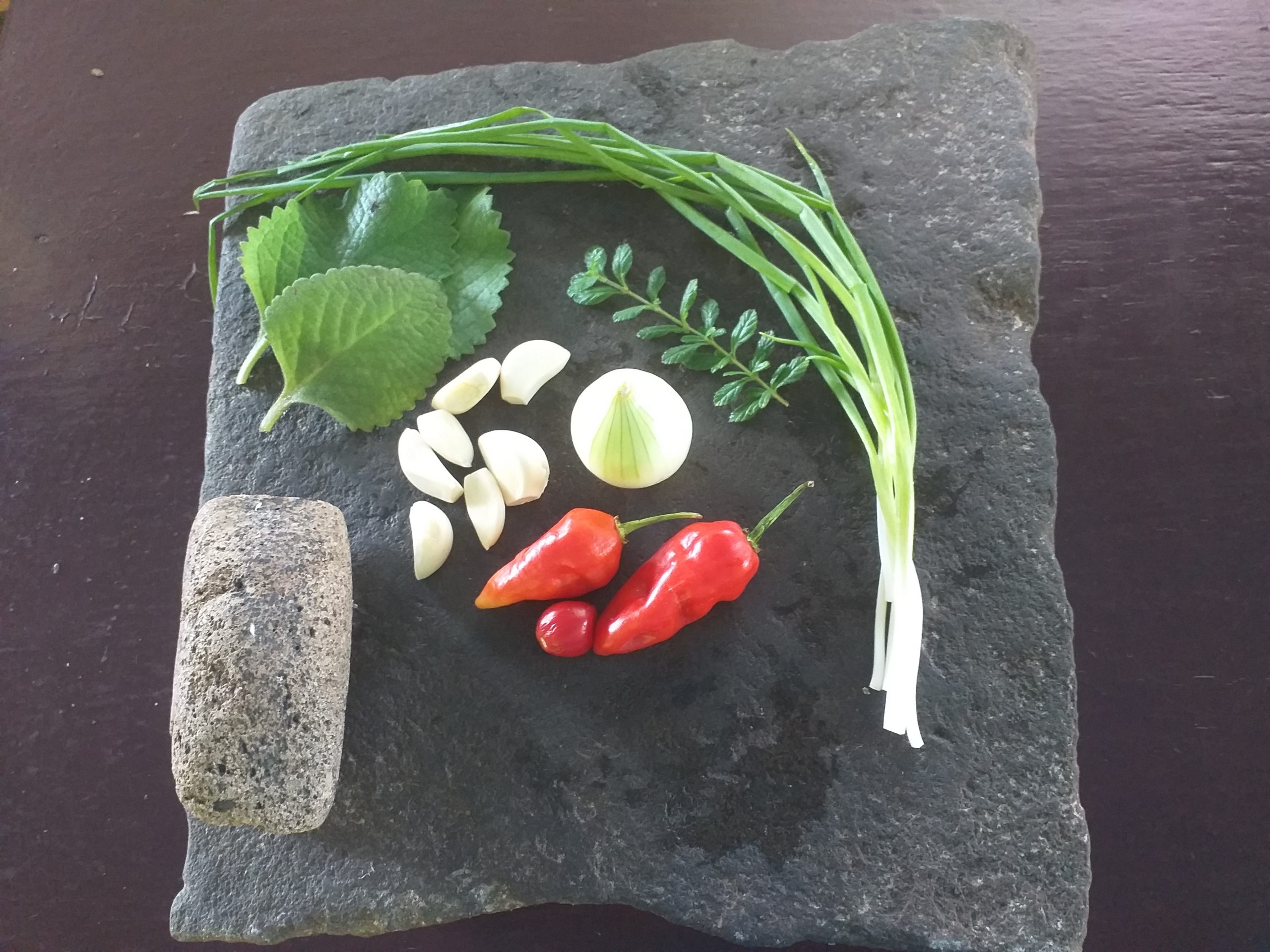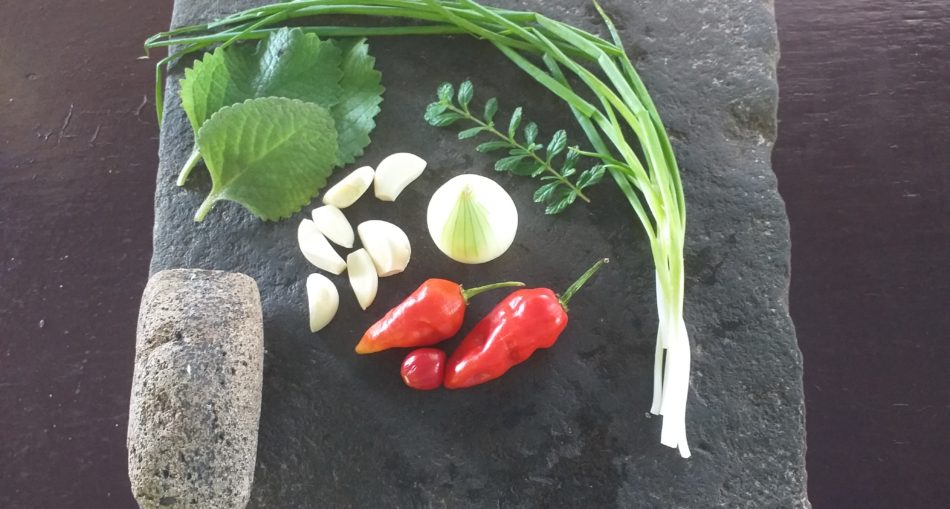The East Indian cuisine is famous for its bold flavours, and spices. Almost all of these recipes incorporate a number of spices. These spices along with other seasonings and even some lentils were minced with grinding tools before being added to dishes. In India, these two stone tools are known as sil batta, but here in Guyana we know as it “Sil and Lorha”. These two tools are essential in the traditional cooking methods which were introduced by the East Indian indentured immigrants to Guyana. These Sil and Lorha are used to ground fresh ingredients to prepare spice mixes, curry pastes, chutneys and even delicious coconut chokhas. This tradition was passed down to generations but it seems to be fading. Many abandon the good, old Sil and Lorha for modern, equipment, unknowingly surrendering the distinctive flavours of traditional Indo-Guyanese cooking.
The Sil and Lorha pair is quite similar to the Mexican batan. in Marathi it is called the pata-varvanta, ammi in Tamil and sila puaa. The Nepali name of this stone implement is silauto-lohoro, which is only slightly different from our local Sil and Lorha. Over time it has been shortened to what we know it as today, Sil and Lorha. In South America and the Andean culture, these stone tools are called the batan (Sil) and una (Lorha).

Sil and Lorha – Photo by Sarika Prasad
Origin of the Sil and Lorha
Like the Belna and Chowki, the Sil and Lorha originated in India but was introduced to Guyana by the East Indian immigrants. However, the batan, a variation of the grinding tool has been used for a long time in South American and Andean cuisine. It is a traditional grinding tool in countries like Peru, Bolivia, Ecuador and Columbia.
Description of The Sil and Lorha
The Sil and Lorha are typically made of the same material-stone. They are made from limestone, granite, or sandstone. The Sil is basically a flat slab of stone, the size and shape of which vary. Although Sils are typically square, they can also be circular. It is possible that the shape depends on the availability of the material. The stone slabs or Sils are usually about one and a half (1.5) feet square, and about three to four (3-4) inches thick. The surface of the Sil tends to be smooth, worn away by years of grinding and use. They are many times the size of the Lorha and cater for enough space to allow for the separation and combination of various spices. The Lorha, also made of stone is a small and handheld cylindrical tool. It is slightly curved at the top and also smooth. The Lorha grinds the ingredients on the Sil, releasing tantalizing aromas and the bold flavours typical of Indian cuisine.
Traditional Uses of The Sil and Lorha
- Traditionally Sil and Lorha is used to grind seasoning for food preparation. Garlic, onion and pepper are the basic ingredients which are crushed under the Lorha then used to prepare different types of curries.
- In addition to this, mixes of spices are ground with the Sil and Lorha.
- Sometimes lentils are soaked then ground to prepare dosas, vadas, or papadum in the Indian cuisine.
- This grinding stone, also known as the batan is used to husk and grind grains in South American and Andean cuisine.
Religious Use of The Sil and Lorha
- In Odisha, a state located in eastern India the sila puaa (Sil and Lorha) is worshipped as a form of Mother Earth or Bhu Devi, during traditional weddings and the Raja festival.
Benefits of Using the Sil and Lorha
- The nutritional value of the lentils and spices are retained when you use Sil and Lorha.
- Using the Sil and Lorha produces a natural, rustic flavour which adds to uniques taste of traditional dishes.
- By grinding your species and seasoning the traditional way, instead of using electrical grinders and equipment, you can also save on electricity costs.
- Manually grinding your ingredients with a Sil and Lorha allows you to choose the texture of your chutney or spices. The taste of your food is also determined by the texture of the ingredients.
About The Sil and Lorha
The Sil and Lorha are passed down from generation to generation in Guyana, as a result, they are something of an heirloom. There are not many Sils and Lorhas in the country because many persons opt to choose the modern grinding equipment, sacrificing the natural flavours. If you’re looking to prepare a traditional Indian meal with bold flavours and spices, make use of the Sil and Lorha which effectively captures the essence of true Indo-Guyanese cooking.
Article References
- https://hummingofthebird.wordpress.com/2017/11/03/ends-tomorrow-indian-indentureship-exhibition-at-national-archives/
- https://www.stabroeknews.com/2017/07/22/the-scene/tastes-like-home/whats-cooking-spices/
- http://guyanainc.biz/tourism-and-culture/culture/unique-items-brought-by-our-fore-parents/
- https://www.guardian.co.tt/article/sil-and-lorha–traditional-indian-kitchen-tools-6.2.1128406.78118e2ca7#:~:text=A%20sil%20is%20a%20cylindrical,Polls%20by%201World%20Online
- https://www.tredyfoods.com/products/traditional-ammi-kal-or-sil-batta
- https://en.wikipedia.org/wiki/Batan_(stone)
- https://khudedpravasi.wordpress.com/2017/02/05/silbatta/
- https://english.newstracklive.com/news/health-benefits-of-chutney-sc96-nu-1034777-1.html
- https://www.nmtv.tv/a-feature-on-the-sil-batta-the-traditional-stone-grinder-of-the-indian-kitchen/








1 Comment